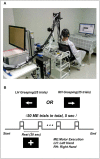Enhancing Performance of a Hybrid EEG-fNIRS System Using Channel Selection and Early Temporal Features
- PMID: 28966581
- PMCID: PMC5605645
- DOI: 10.3389/fnhum.2017.00462
Enhancing Performance of a Hybrid EEG-fNIRS System Using Channel Selection and Early Temporal Features
Abstract
Brain-Computer Interface (BCI) techniques hold a great promise for neuroprosthetic applications. A desirable BCI system should be portable, minimally invasive, and feature high classification accuracy and efficiency. As two commonly used non-invasive brain imaging modalities, Electroencephalography (EEG) and functional near-infrared spectroscopy (fNIRS) BCI system have often been incorporated in the development of hybrid BCI systems, largely due to their complimentary properties. In this study, we aimed to investigate whether the early temporal information extracted from singular EEG and fNIRS channels on each hemisphere can be used to enhance the accuracy and efficiency of a hybrid EEG-fNIRS BCI system. Eleven healthy volunteers were recruited and underwent simultaneous EEG-fNIRS recording during a motor execution task that included left and right hand movements. Singular EEG and fNIRS channels corresponding to the motor cortices of each hemisphere were selected using a general linear model. Early temporal information was extracted from the EEG channel (0-1 s) along with initial hemodynamic dip information from fNIRS (0-2 s) for classification using a support vector machine (SVM). Results demonstrated a lofty classification accuracy using a minimal number of channels and features derived from early temporal information. In conclusion, a hybrid EEG-fNIRS BCI system can achieve higher classification accuracy (91.02 ± 4.08%) and efficiency by integrating their complimentary properties, compared to using EEG (85.64 ± 7.4%) or fNIRS alone (85.55 ± 10.72%). Such a hybrid system can also achieve minimal response lag in application by focusing on rapidly-evolving brain dynamics.
Keywords: EEG; NIRS; general linear model; hybrid BCI; principal component analysis.
Figures







References
-
- Blankertz B., Tomioka R., Lemm S., Kawanabe M., Muller K. R. (2008). Optimizing spatial filters for robust EEG single-trial analysis. IEEE Signal. Process. Mag. 25, 41–56. 10.1109/MSP.2008.4408441 - DOI
LinkOut - more resources
Full Text Sources
Other Literature Sources
Research Materials

